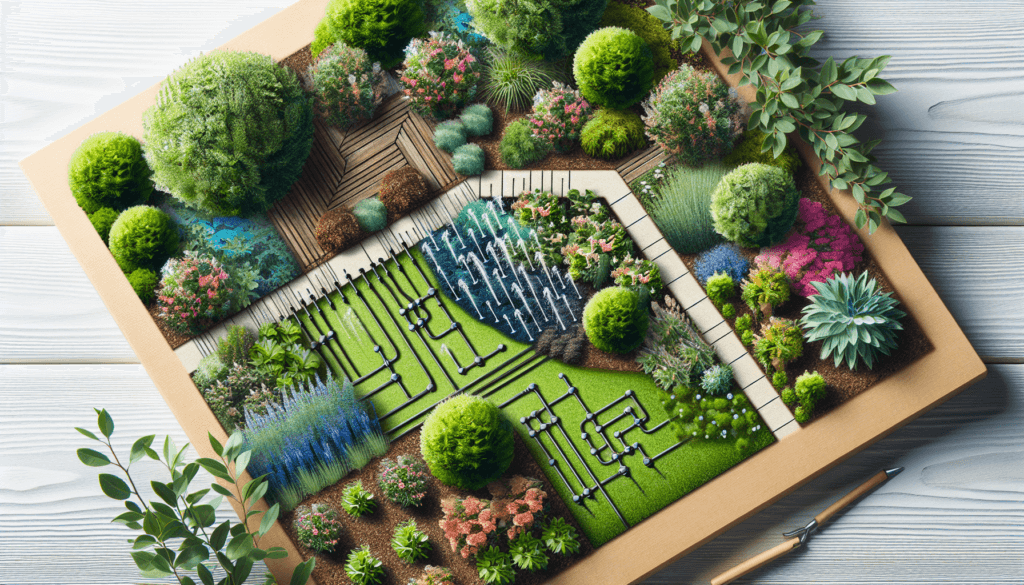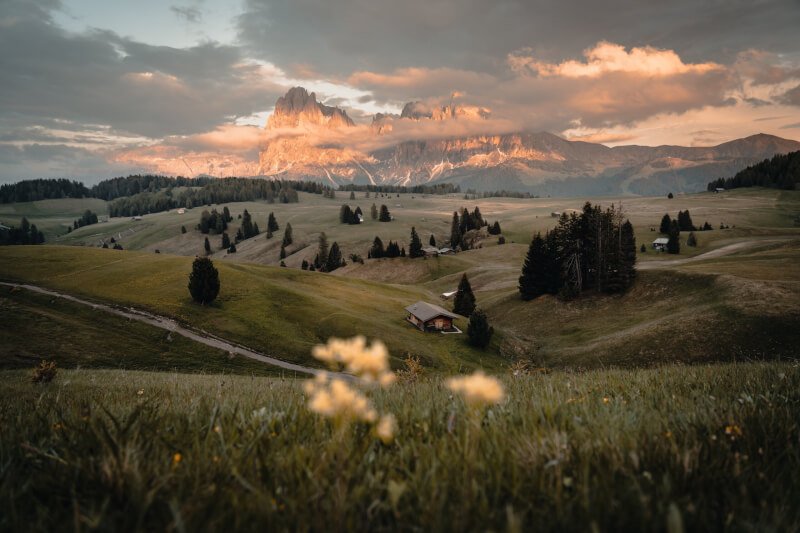Are you tired of spending countless hours tending to your garden, only to have it become overgrown and chaotic again in a matter of weeks? If so, then you’re in luck! In this article, we will explore the best ways to design a low-maintenance garden, allowing you to enjoy the beauty of nature without the constant upkeep. From choosing the right plants to implementing clever design strategies, we will arm you with the knowledge to create a stunning, yet effortlessly manageable, outdoor space. So let’s get started on transforming your garden into a stress-free oasis!

Selecting the Right Plants
Choosing Native Plants
When it comes to designing a low-maintenance garden, one of the first steps is to select the right plants. One of the best ways to ensure a garden that requires minimal care is to opt for native plants. Native plants are naturally adapted to the local climate and soil conditions, making them more resilient and less prone to disease and pests. In addition, native plants typically require less water and fertilizer, making them an eco-friendly choice for a low-maintenance garden.
Opting for Perennials
Another great way to reduce the maintenance required in your garden is to choose perennials instead of annuals. Perennials are plants that come back year after year, whereas annuals need to be replanted each year. By selecting perennials, you can enjoy the beauty of your garden without the hassle of replanting every season. Perennials also tend to have deeper root systems, which makes them more drought-tolerant and requires less frequent watering.
Using Drought-Tolerant Plants
Water conservation is an essential aspect of designing a low-maintenance garden. By selecting drought-tolerant plants, you can significantly reduce the amount of water needed to keep your garden thriving. Drought-tolerant plants have adapted to survive with minimal water, making them ideal for regions with limited rainfall or water restrictions. These plants typically have low water requirements and can withstand dry spells without significant damage. Incorporating a variety of drought-tolerant plants in your garden not only saves water but also minimizes the time and effort required for watering.
Creating Efficient Layout
Grouping Plants by Watering Needs
An efficient garden layout is crucial for reducing maintenance tasks. One way to achieve this is by grouping plants with similar watering needs together. By clustering plants with similar water requirements, you can create efficient watering zones and avoid overwatering or underwatering specific areas of your garden. This not only saves water but also enables you to automate irrigation systems more easily, further reducing the maintenance needed for watering.
Utilizing Mulch and Ground Covers
Mulch and ground covers are essential elements for a low-maintenance garden design. The use of organic mulch, such as wood chips or shredded bark, helps retain moisture in the soil, suppresses weed growth, and insulates plant roots from extreme temperatures. Ground covers, such as low-growing plants or spreading shrubs, also provide additional weed suppression benefits and reduce the need for manual weeding. By incorporating mulch and ground covers strategically throughout your garden, you can minimize maintenance tasks while enhancing the overall aesthetic.
Considering Plant Spacing
Proper plant spacing is crucial for a low-maintenance garden design. By giving plants enough room to grow, you can prevent overcrowding and competition for resources, such as sunlight, water, and nutrients. Overcrowding can lead to increased maintenance needs, as plants may require more frequent pruning, thinning, or dividing. It is important to consider the mature size of each plant and provide adequate spacing to ensure their healthy growth, reduce the need for excessive maintenance, and maintain an aesthetically pleasing garden.
Implementing Smart Watering Techniques
Installing Drip Irrigation Systems
Efficient watering is key to maintaining a low-maintenance garden. Installing a drip irrigation system is an excellent way to provide water directly to the roots of your plants, minimizing water loss through evaporation and reducing the need for hand watering. Drip irrigation systems can be easily automated and tailored to the specific watering needs of different areas in your garden. By utilizing a drip irrigation system, you can conserve water, save time, and ensure that your plants receive the right amount of water without overwatering or underwatering.
Utilizing Rainwater Harvesting
Rainwater harvesting is an eco-friendly and cost-effective way to water your garden. By collecting rainwater, you can reduce your reliance on freshwater sources and lower your water bill. Installing rain barrels or cisterns allows you to capture and store rainwater for later use during dry periods. This stored rainwater can then be used to irrigate your garden, providing a natural and sustainable water source. By incorporating rainwater harvesting into your garden design, you can minimize your maintenance efforts while promoting environmental sustainability.
Using Self-Watering Containers
For those who prefer container gardening or have limited space, using self-watering containers can be a game-changer. Self-watering containers feature a reservoir that holds water and a wicking system that delivers water directly to the plant’s roots as needed. This innovative design ensures that plants receive consistent moisture without the risk of overwatering or underwatering. Self-watering containers minimize the frequency of watering required, making them an excellent choice for a low-maintenance garden.
Reducing Maintenance through Smart Design
Designing Paths and Walkways
Including well-designed paths and walkways in your garden not only enhances its aesthetics but also reduces maintenance. By creating defined pathways, you can prevent trampling on delicate plants and minimize the spread of weeds. Opt for low-maintenance materials, such as gravel, stone pavers, or mulch, for your paths, as they require little upkeep and provide a visually pleasing element to your garden design.
Incorporating Weed Barriers
Weeds can quickly overrun a garden, increasing maintenance requirements. Incorporating weed barriers, such as landscape fabric or mulch, can effectively suppress weed growth and significantly reduce the time devoted to weeding. Weed barriers serve as a physical barrier that prevents weed seeds from germinating and competing with your desired plants. When combined with proper mulching, weed barriers can help keep your garden weed-free and low-maintenance.
Installing Low-Maintenance Features
When designing a low-maintenance garden, it is essential to consider incorporating low-maintenance features. This may include installing automated lighting systems, motion-activated sprinklers, or low-maintenance hardscapes, such as artificial turf or decorative rocks. By incorporating these features into your garden design, you can minimize time-consuming maintenance tasks while still enjoying a beautiful and functional outdoor space.

Minimizing Lawn Areas
Replacing Lawn with Alternatives
Lawn areas can be high maintenance, requiring frequent mowing, watering, and fertilizing. To reduce the maintenance and resource consumption associated with a traditional lawn, consider replacing it with alternative ground covers or landscaped areas. Ground covers like creeping thyme, clover, or ornamental grasses can provide a lush and visually appealing alternative to a traditional lawn while requiring less maintenance and resources.
Reducing Lawn Size
If removing your lawn entirely is not desired, another option is to reduce its size. By shrinking the lawn area, you can decrease the amount of time and effort spent on maintenance tasks like mowing and watering. Consider converting sections of the lawn into flower beds, vegetable gardens, or outdoor seating areas, creating a more diverse and low-maintenance landscape.
Designing for Easy Access and Maintenance
Creating Wide Pathways
In addition to paths and walkways, it is essential to consider creating wide pathways for easy access and maintenance. Wide pathways not only accommodate garden maintenance equipment but also provide comfortable and accessible routes for navigating the garden. With wider paths, you can easily maneuver wheelbarrows, carts, or gardening tools without damaging plants or compacting the soil excessively.
Installing Raised Beds or Containers
Raised beds and containers are excellent options for a low-maintenance garden design. By elevating your plants in raised beds or containers, you can control the soil conditions, minimize weed growth, and improve drainage. Raised beds also provide a more ergonomic gardening experience, reducing the strain on your back and knees. Containers can be moved around easily, allowing you to adjust the layout and create a dynamic and low-maintenance garden.
Including Easy-to-Reach Features
When designing your garden, it is important to consider including easy-to-reach features to minimize maintenance tasks. This may include incorporating compost bins, rain barrels, or tool sheds in convenient locations. By ensuring that essential features are easily accessible, you can streamline your maintenance routines and save time and effort when tending to your garden.

Choosing Low-Maintenance Garden Structures
Opting for Durable and Weather-Resistant Materials
When selecting garden structures, prioritize durability and weather resistance. Choose materials that can withstand the elements and require minimal maintenance, such as aluminum, stainless steel, or composite materials. Investing in high-quality, resilient structures ensures that your garden remains attractive and functional with minimal upkeep.
Utilizing Minimalist Designs
Embracing minimalist designs can greatly reduce maintenance requirements in your garden. Clean lines, simple shapes, and a restrained color palette can create an elegant and timeless aesthetic while minimizing the need for constant upkeep. By avoiding intricate or high-maintenance design elements, you can create a low-maintenance garden that is both visually appealing and easy to care for.
Selecting Low-Maintenance Fencing
The choice of fencing material can also play a significant role in the maintenance needs of your garden. Opt for low-maintenance fencing options like vinyl, aluminum, or composite materials. These materials are durable, resistant to rot and pests, and require minimal upkeep, such as painting or staining. Choosing low-maintenance fencing ensures that your garden remains secure and beautiful without requiring frequent repairs or maintenance.
Planning for Year-Round Interest
Incorporating Evergreen Plants and Trees
To create a garden that is visually appealing throughout the year, incorporate evergreen plants and trees. Evergreens retain their foliage year-round, providing color, texture, and structure to your garden during the winter months. By including a variety of evergreen species, you can ensure that your garden remains vibrant and interesting even when other plants go dormant. Evergreen plants also tend to be low-maintenance, with minimal pruning or maintenance needs.
Introducing Colorful Blooms in Different Seasons
Adding colorful blooms to your garden in different seasons ensures year-round interest and reduces maintenance efforts. Select plants that bloom at different times of the year, such as spring-flowering bulbs, summer annuals, or fall-blooming perennials. By strategically planting a diverse range of flowering plants, you can enjoy vibrant blooms throughout the year and minimize the need for constant replanting or additional maintenance.
Adding Ornamental Grasses and Shrubs
Ornamental grasses and shrubs are excellent additions to a low-maintenance garden design. Not only do they provide texture and movement to your garden, but they also require minimal care and attention. Once established, ornamental grasses and shrubs are generally drought-tolerant, disease-resistant, and require little pruning or maintenance. Their natural resilience and beautiful aesthetic make them ideal options for a low-maintenance garden.

Implementing Sustainable Gardening Practices
Composting and Mulching
Composting and mulching are essential sustainable gardening practices that can significantly reduce maintenance needs. Composting allows you to recycle organic waste and create nutrient-rich soil amendments, reducing the need for chemical fertilizers. Mulching helps retain moisture, suppress weed growth, and improve soil health, reducing the need for watering and weeding. By incorporating these practices into your gardening routine, you can create a self-sustaining ecosystem that requires minimal external inputs.
Using Organic Pest Control Methods
Pests can be a significant source of maintenance in a garden. Instead of relying on chemical pesticides, consider using organic pest control methods. This may include introducing beneficial insects like ladybugs or lacewings that prey on garden pests, using natural repellents like garlic or neem oil, or practicing companion planting to deter pests. By promoting a healthy and balanced ecosystem, you can naturally control pests and minimize the need for frequent pesticide application or manual pest removal.
Encouraging Beneficial Insects
Another sustainable gardening practice is to encourage beneficial insects that contribute to pest control and pollination. Beneficial insects, such as bees, butterflies, or ladybugs, play a vital role in maintaining a healthy garden ecosystem. By creating a habitat that attracts these beneficial insects with nectar-rich flowers, water sources, and shelter, you can reduce the need for pest control measures and promote a thriving and balanced garden environment.
Regular Maintenance Tips
Weeding and Pruning Regularly
Even with a well-designed and low-maintenance garden, some regular maintenance tasks are necessary. Weeding and pruning are two essential tasks that should be performed regularly to keep your garden in top shape. By removing weeds before they have a chance to spread and compete with your desired plants, you can save time and effort in the long run. Pruning helps maintain plant health, control size and shape, and encourage strong growth. Regular weeding and pruning keep your garden looking neat and tidy while minimizing the need for more intensive maintenance later on.
Monitoring Watering Needs
While implementing smart watering techniques can significantly reduce the maintenance required for watering, it is still important to monitor your plants’ watering needs. Environmental factors, such as temperature and rainfall, can influence the water requirements of your garden. Regularly check the moisture levels in the soil and adjust your watering schedule accordingly. By ensuring that your plants receive the right amount of water, you can prevent overwatering or underwatering, promoting their health and longevity.
Fertilizing Wisely
Proper fertilization is crucial for maintaining healthy and thriving plants. However, excessive or improper use of fertilizers can lead to increased maintenance needs, such as excessive growth or nutrient imbalances. It is important to fertilize wisely and follow the recommended guidelines for your specific plants. Consider using slow-release or organic fertilizers, as they provide a more balanced and sustained nutrient supply to your plants. By fertilizing wisely, you can promote plant health and minimize the need for additional maintenance tasks.
In conclusion, designing a low-maintenance garden involves a thoughtful approach and careful selection of plants, efficient layout, smart watering techniques, reducing lawn areas, easy access and maintenance, low-maintenance garden structures, year-round interest planning, sustainable gardening practices, and regular maintenance. By implementing these strategies, you can create a beautiful and low-maintenance garden that allows you to spend more time enjoying its beauty and less time on maintenance tasks. Happy gardening!



